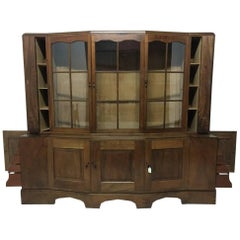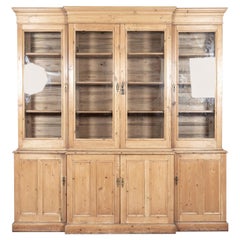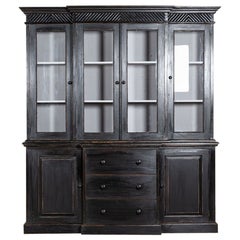Edward Barnsley Case Pieces and Storage Cabinets
Collectors the world over consider furniture maker Edward Barnsley one of the most influential figures in British design. Bringing his own touch to the local standard of crafting, Barnsley worked with rare hardwoods, such as rosewood and black bean, as well the staples of the Arts and Crafts style, like oak and walnut. His use of fine lines, delicate curves and detailed inlays set his work apart from that of his predecessors.
From Hampshire County, England, Barnsley was practically born to be a furniture maker. His father, Sydney, uncle Ernest and a family friend all practiced the craft and were strong influences on young Edward. At 10, he enrolled in Bedales, a progressive school focusing on practical skills and craftwork.
In 1920, after completing his studies, Barnsley returned to Hampshire and began employment at the workshop of local furniture maker and construction carpenter Geoffrey Lupton. In 1923, Lupton turned over his furniture workshop and client list to Barnsley. When his father died in 1926, Barnsley inherited his father's customers as well.
Barnsley employed numerous craftspeople and laborers — including the notable British furniture maker Alan Peters — increasing production immeasurably beyond that of his predecessors. The workshop created more than 7,000 individual works over the course of his leadership.
When electricity arrived to the shop in 1955, Barnsley was apprehensive about overutilizing mechanical means of production, believing the craftsperson's skill vital to making each piece a success. However, using machines to plane and sand the wood quickly became commonplace at the workshop, helping to boost production significantly.
Throughout his career, Barnsley often took the time to lecture at Loughborough College, passing on his wisdom and understanding of his craft to the next generation. He was also a founding member of the Crafts Council of England, and in 1945, received the title of Commander of the Order of the British Empire (CBE).
After Barnsley died in 1987, his widow and children gave substantial contributions to the workshop, helping to ensure its financial security for the future. Although Edward Barnsley is gone, the Edward Barnsley Workshop lives on — crafting outstanding furniture with the same level of perfection and vision as its namesake.
On 1stDibs, explore antique Edward Barnsley seating, case pieces and decorative objects.
1930s English Arts and Crafts Vintage Edward Barnsley Case Pieces and Storage Cabinets
Ebony, Walnut, Bog Wood
1940s English Vintage Edward Barnsley Case Pieces and Storage Cabinets
Pine
Mid-20th Century Edward Barnsley Case Pieces and Storage Cabinets
Pine
1820s English George III Antique Edward Barnsley Case Pieces and Storage Cabinets
Brass
1880s British Antique Edward Barnsley Case Pieces and Storage Cabinets
Mahogany
Late 19th Century English Chippendale Antique Edward Barnsley Case Pieces and Storage Cabinets
Mahogany, Glass
1980s American Georgian Vintage Edward Barnsley Case Pieces and Storage Cabinets
Brass
19th Century Antique Edward Barnsley Case Pieces and Storage Cabinets
Pine
Early 2000s American Georgian Edward Barnsley Case Pieces and Storage Cabinets
Oak
Mid-19th Century English Campaign Antique Edward Barnsley Case Pieces and Storage Cabinets
Mahogany
Mid-20th Century American Edward Barnsley Case Pieces and Storage Cabinets
Glass, Mahogany, Satinwood
19th Century English Neoclassical Antique Edward Barnsley Case Pieces and Storage Cabinets
Brass
1980s American French Provincial Vintage Edward Barnsley Case Pieces and Storage Cabinets
Brass


